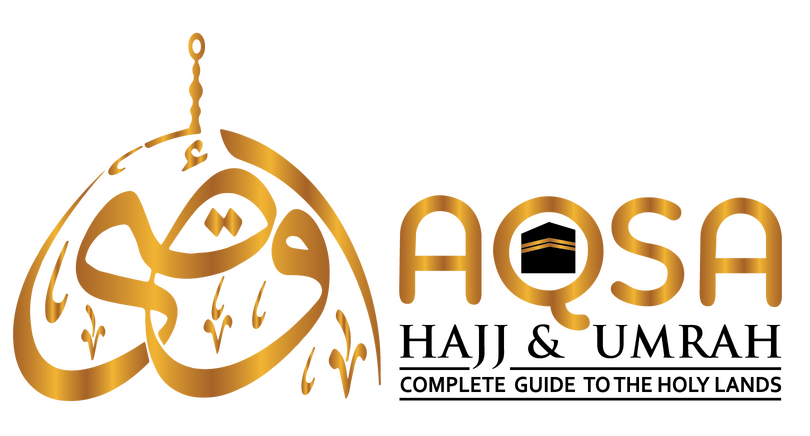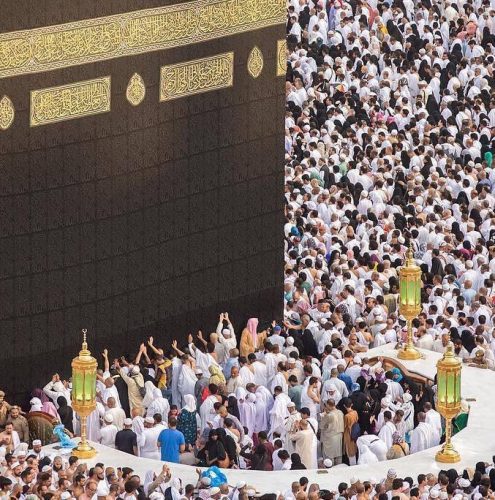Performing Umrah is a deeply spiritual journey undertaken by Muslims seeking closeness to Allah (SWT). Understanding the core Umrah rituals explained step-by-step is crucial for a fulfilling and accepted pilgrimage. This simple Umrah guide breaks down the four essential rites: entering the state of Ihram, performing Tawaf around the Kaaba, completing Sa’i between Safa and Marwah, and finally, Halq or Taqsir (shaving or trimming the hair).
At Aqsa Umrah and Hajj Services, your Pennsylvania-based Umrah specialists, we want to ensure every pilgrim feels confident and prepared. Let’s explore how to perform Umrah correctly.
1. Ihram: Entering the Sacred State
Ihram is not just the specific clothing worn but the sacred state a pilgrim enters at designated points called Miqat. It signifies your intention to perform Umrah and involves adhering to certain prohibitions.
Significance: Entering Ihram symbolizes shedding worldly attachments and entering a state of purity and devotion, equalizing all pilgrims before Allah (SWT).
Steps:
- Preparation (Before Miqat): Perform Ghusl (ritual bath) – a highly recommended Sunnah. Trim nails and remove unwanted body hair. Men may apply unscented oil or perfume to their bodies (not clothes) before putting on Ihram garments.
- Wearing Ihram Garments:
- Men: Wear two clean, preferably white, unstitched cloths – the Izar (waist wrapper) and Rida (upper body shawl). Footwear should leave the ankles and the top part of the foot (around the laces area) exposed. [Illustration Idea: Simple diagram showing how to wear the Izar and Rida].
- Women: Wear regular, modest Islamic clothing covering the entire body except for the face and hands. Any color is permissible, but avoid overly decorative attire. Socks may be worn.
- Salah al-Ihram (Optional but Recommended): Perform two Rak’ahs of Nafl Salah before making the intention, preferably after putting on the Ihram garments but before reaching the Miqat.
- Niyyah (Intention): At the designated Miqat point (or just before reaching it if traveling by plane/train), make the clear intention in your heart to perform Umrah. It’s recommended to verbalize it, for example: “Labbayka Allahumma Umrah” (O Allah, here I am for Umrah).
- Talbiyah: Immediately after making the Niyyah, recite the Talbiyah to formally enter the state of Ihram. This is essential. Recite it frequently throughout your journey until you begin Tawaf.
- “Labbayka Allahumma labbayk, labbayka la sharika laka labbayk, inna l-hamda wa n-ni’mata, laka wa l-mulk, la sharika lak.” (At Your service, Allah, at Your service. At Your service, You have no partner, at Your service. Truly all praise, favour and sovereignty are Yours. You have no partner.)
Prohibitions of Ihram: Once in Ihram, avoid: using perfumes, cutting/plucking hair or nails, covering the head (men), covering the face (women, unless necessary due to presence of non-Mahram men), wearing stitched clothing conforming to the body shape (men), hunting, sexual relations, and engaging in arguments or futile talk.
Common Mistakes: Forgetting to make Niyyah at Miqat, reciting Talbiyah incorrectly or not at all, violating prohibitions unknowingly.
2. Tawaf: Circumambulating the Kaaba
Tawaf is the ritual circumambulation of the Holy Kaaba seven times in an anti-clockwise direction.
Significance: Tawaf symbolizes the unity of believers revolving around one center – the worship of the One God, Allah (SWT). It mirrors the Tawaf of angels around the Throne of Allah.
Steps:
- Enter Masjid al-Haram: Enter with your right foot first, reciting the recommended Dua for entering a mosque.
- Prepare for Tawaf: Ensure you are in a state of Wudu (ablution). Men should perform Idtiba – uncovering the right shoulder by passing the Rida under the right armpit and draping it over the left shoulder. This is done only during Tawaf al-Umrah.
- Start at Hajar al-Aswad (Black Stone): Position yourself facing the corner of the Kaaba where the Black Stone is located. Make Niyyah for Tawaf.
- Istilam (Kissing/Touching/Pointing): If possible without harming others, kiss the Hajar al-Aswad. If not possible, touch it with your right hand and kiss your hand. If even that is not possible, face the stone and gesture towards it with your right hand (palms facing the stone) once only, and recite “Bismillahi Allahu Akbar” (In the name of Allah, Allah is the Greatest). Do not kiss your hand after gesturing.
- Begin Circuits: Start circumambulating anti-clockwise, keeping the Kaaba to your left.
- Raml (Men Only): During the first three circuits, men should perform Raml – walking briskly, taking short steps, puffing out the chest, and moving the shoulders (like a warrior). Walk normally during the remaining four circuits. Women walk normally throughout.
- Supplications: Recite Quran, Dhikr, or personal Duas during Tawaf. Between the Yemeni Corner (Rukn Yamani) and the Hajar al-Aswad, it is Sunnah to recite: “Rabbana atina fi d-dunya hasanatan wa fi l-akhirati hasanatan wa qina ‘adhaban-nar” (Our Lord, give us good in this world and good in the Hereafter, and save us from the punishment of the Fire).
- Rukn Yamani (Yemeni Corner): If possible, touch the Yemeni Corner with your right hand (or both hands) during each circuit. Do not kiss it or gesture towards it if you cannot reach it. Recite “Bismillahi Allahu Akbar” when touching it.
- Complete Seven Circuits: Each circuit starts and ends at the Hajar al-Aswad. Perform Istilam (as described in step 4) at the beginning of each circuit (total 8 times – once before starting and once at the beginning of each of the 7 circuits).
- Cover Right Shoulder: After completing 7 circuits, men cover their right shoulder.
- Maqam Ibrahim: Go behind the Maqam Ibrahim (Station of Abraham) – or anywhere nearby in the Haram if crowded – and offer two Rak’ahs of Salah. It is Sunnah to recite Surah Al-Kafirun in the first Rak’ah and Surah Al-Ikhlas in the second after Al-Fatiha.
- Drink Zamzam Water: Proceed to drink Zamzam water, facing the Kaaba if possible, and make Dua.
[Illustration Idea: Diagram showing the Kaaba, Hajar al-Aswad, Rukn Yamani, Maqam Ibrahim, and the direction of Tawaf, indicating start/end point and areas for Raml].
Common Mistakes: Performing Tawaf clockwise, starting from a corner other than Hajar al-Aswad, excessive pushing to kiss the Black Stone, performing Raml in all seven circuits or women performing Raml, forgetting the Salah after Tawaf.
3. Sa’i: Walking Between Safa and Marwah
Sa’i involves walking back and forth seven times between the hills of Safa and Marwah.
Significance: Sa’i commemorates the struggle of Hajar (RA), the wife of Prophet Ibrahim (AS), as she ran between Safa and Marwah searching for water for her infant son, Ismail (AS).
Steps:
- Proceed to Safa: After drinking Zamzam, head towards the hill of Safa.
- Niyyah & Dua at Safa: Upon reaching Safa, make the Niyyah for Sa’i. Face the Kaaba, raise your hands in Dua, recite Takbir (Allahu Akbar), Tahleel (La ilaha illallah), and send Salawat upon the Prophet ﷺ. Make personal Duas. It is Sunnah to recite the Quranic verse: “Inna s-Safa wa l-Marwata min sha’a’iri llah…” (Indeed, Safa and Marwah are among the symbols of Allah…) [Quran 2:158].
- Begin Walk to Marwah: Start walking towards Marwah. Engage in Dhikr and Dua.
- Green Lights: Between the two sets of green lights/markers along the path (the Milayn al-Akhdharayn), men should run at a medium pace. Women should continue walking normally.
- Reach Marwah: Upon reaching Marwah, face the Kaaba, raise hands, and repeat the supplications and Duas as done at Safa. This completes one lap.
- Walk Back to Safa: Walk back towards Safa (running between the green lights for men). Reaching Safa completes the second lap.
- Complete Seven Laps: Continue walking back and forth until you complete seven laps, ending at Marwah.
[Illustration Idea: Simple map showing Safa, Marwah, the walking path, and the area marked by green lights].
Common Mistakes: Starting Sa’i from Marwah, not completing seven full laps, women running between the green lights, stopping for lengthy Duas mid-lap causing obstruction.
4. Halq or Taqsir: Shaving or Trimming the Hair
This is the final ritual, signifying the exit from the state of Ihram.
Significance: It symbolizes detachment from worldly adornments and submission to Allah (SWT).
Steps:
- After Sa’i: Upon completing the seventh lap of Sa’i at Marwah, men should preferably perform Halq (shaving the entire head). Alternatively, they can perform Taqsir (trimming hair evenly from all parts of the head, at least the length of a fingertip).
- Women: Women perform Taqsir only. They should gather their hair and trim about a fingertip’s length from the ends.
Completion: With the completion of Halq or Taqsir, you are released from the state of Ihram, and all its restrictions are lifted. Your Umrah is complete.
Common Mistakes: Men trimming only a few strands of hair instead of from all parts of the head for Taqsir, women trimming their own hair in public view.
Conclusion
Understanding and performing these Umrah rituals correctly enhances the spiritual value of your pilgrimage. While this Umrah guide provides the steps, sincerity, devotion, and seeking Allah’s acceptance are paramount.
Planning your Umrah from Pennsylvania or anywhere in the USA? Let Aqsa Umrah and Hajj Services assist you with expert guidance, visa processing, and tailored packages for a blessed and hassle-free journey. Contact us today!

